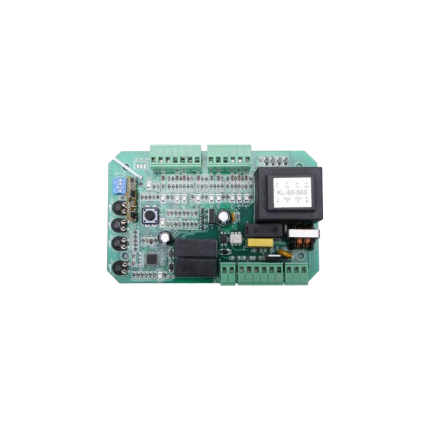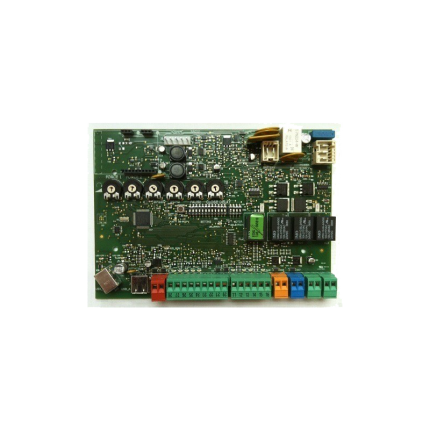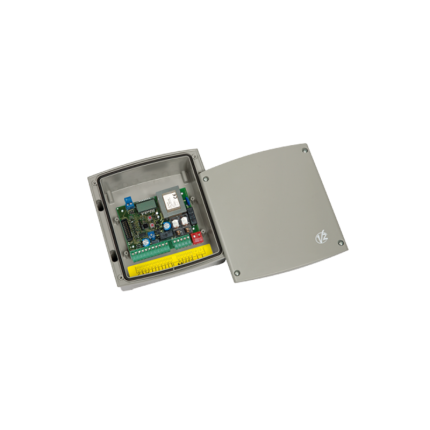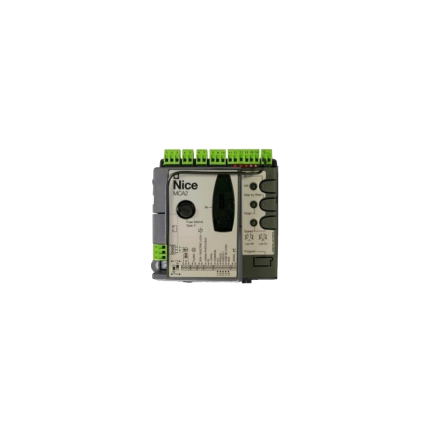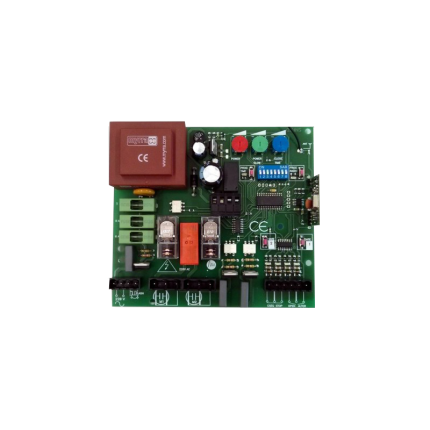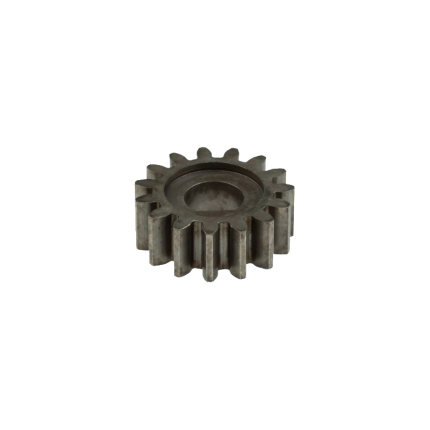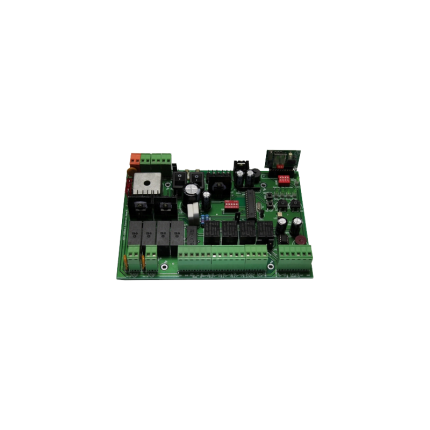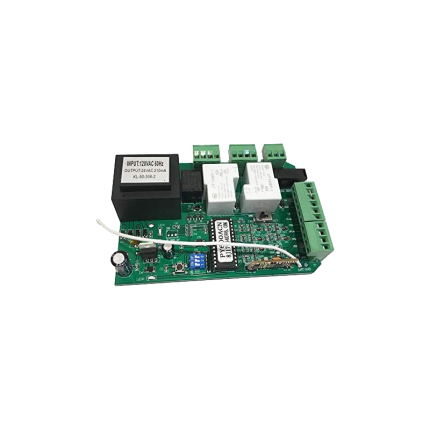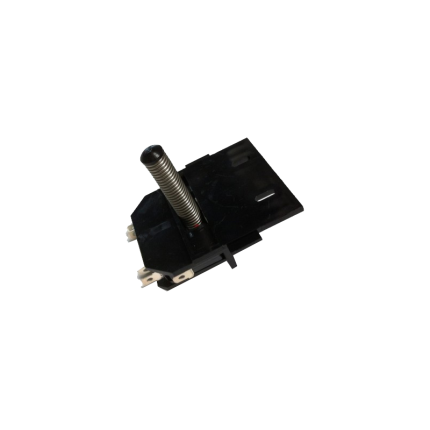Accessories
Sliding gate operator main control board – Zero
Ship or pick up from our office.
Sliding gate operator main control board – Zero
The sliding gate operator main control board (also referred to as a PCB or circuit board) is the central component that manages all the functions of an automatic sliding gate system.
It acts as the "brain" of the gate, receiving signals from various input devices (like remote controls, keypads, or safety sensors) and translating them into actions for the gate's motor and other components.
Here's a more detailed breakdown:
1. Central Control: The control board is the central hub for all gate operations. It receives signals from different sources, such as:
- Remote controls: For opening and closing the gate.
- Keypads: For authorized access.
- Safety sensors: To detect obstructions and prevent accidents.
- Other accessories: Such as loop detectors, intercom systems, etc.
2. Signal Processing: The control board interprets the signals it receives and determines the appropriate action for the gate.
3. Motor Activation: Based on the processed signal, the control board sends instructions to the gate's motor to either open or close the gate.
4. Adjustable Settings: The control board often allows for adjustments to various parameters, including:
- Gate speed: The speed at which the gate opens and closes.
- Opening and closing timers: To control the duration of the gate's movement.
- Safety features: Including force adjustments, obstacle detection sensitivity, and slow-down settings.
Sliding gate operator main control board – VDS
Ship or pick up from our office.
Sliding gate operator main control board – VDS
The VDS SIMPLY sliding gate operator's main control board is the central unit that controls the operation of a sliding gate, typically one that weighs up to 600kg.
It's made by VDS Automation, an Italian company known for its gate automation products.
This control board manages functions like opening and closing the gate, potentially adjusting speed and force, and integrating with accessories such as keypads and safety sensors.
-
Central Control:The control board acts as the brain of the gate, receiving signals from remote controls or other input devices and translating them into actions for the gate's motor and other components.
-
Remote Control Integration:It typically includes a built-in radio receiver that can be programmed to work with VDS remote controls.
-
Safety Features:The control board can manage safety mechanisms like anti-squashing systems and potentially adjustable speed and force settings.
-
Easy Installation and Programming:The VDS SIMPLY control board is designed for easy installation, often featuring pre-wired components and straightforward programming.
-
Optional Accessories:It can be integrated with optional accessories like keypads, safety sensors, and other components to enhance functionality.
-
Durability:The control unit is often housed in a box with an air-stop seal to protect it from moisture and insects, and the mechanical parts may be lubricated with lithium grease for longevity.
-
Italian Manufacturing:VDS (Simply SL110) is specifically mentioned as an Italian-made control board, emphasizing quality and reliability.
Sliding gate operator main control board – Difermatic
Ship or pick up from our office.
Sliding gate operator main control board – Difermatic
The main control board for a Difermatic sliding gate operator, such as the DSL600, acts as the "brain" of the system, managing all the gate's functions.
It receives commands from remote controls or other inputs, and then controls the motor to open and close the gate. It also manages safety features like obstacle detection and may allow for adjustments to speed, force, and other parameters.
Key Functions:
- Receives and Processes Commands: The control board receives signals from remote controls, keypads, or safety sensors.
- Controls the Motor: It sends instructions to the gate's motor to open or close the gate based on the received commands.
- Manages Safety Features: Many control boards include safety features like obstacle detection (which can reverse the gate's direction if it encounters an obstruction) and slow-down functions.
- Adjustable Settings: Some models allow for adjustment of speed, force, and other parameters.
- Power Supply: The control board typically operates on a 24V power supply.
Specific to Difermatic:
- The Difermatic DSL600 is a 600kg sliding gate opener, indicating the weight capacity of the gate it's designed to handle.
- Difermatic products are known for their Italian design and quality.
- The control board likely has features like remote control operation, safety mechanisms, and adjustable speed and force settings.
Additional Notes:
- Many sliding gate control boards, including those from Difermatic, are designed for easy installation and user-friendly operation.
- They often include a built-in receiver for remote controls and may be compatible with other accessories like photocells and alarm lamps.
- Some control boards also feature automatic closing functions and can be programmed for various delay times.
Swing gate operator main control board – VDS (Underground RG24)
Ship or pick up from our office.
Swing gate operator main control board – VDS (Underground RG24)
The swing gate operator main control board for the VDS Underground RG24 is a key component that manages the operation of the gate.
It receives power, processes signals from remote controls and safety devices, and controls the movement of the underground actuator arm to open and close the gate.
The swing gate operator main control board is designed to be fully programmable and compatible with the VDS RG24 underground electromechanical motor, typically with 120V input power.
Here's a more detailed explanation about swing gate operator:
-
Function:The main control board acts as the "brain" of the gate operator system. It receives input from various devices (like remote controls, safety sensors, etc.) and sends appropriate signals to the motor to control the gate's movement.
-
Power Input:The VDS Underground RG24 swing gate operator main control board typically requires a 120V AC input power supply.
-
Programming:It's fully programmable, meaning it can be configured to work with different gate types, safety features, and operational modes.
-
Compatibility:It's designed specifically for the VDS RG24 underground electromechanical motor.
-
Components:The VDS RG24 system typically includes the underground actuator arm and a separate control box that houses the main control board.
-
Safety Features:Modern control boards often include safety features like anti-crushing detection and slowdown capabilities to prevent accidents.
-
Optional Features:Many control boards can be integrated with optional features like battery backup, remote controls, and safety sensors.
Swing gate operator main control board – V2
Ship or pick up from our office.
Swing gate operator main control board – V2
The Swing gate operator main control board V2, often referred to as the CALYPSO board, is a crucial component for swing gate automation systems.
It serves as the central hub for controlling the gate's movement, receiving commands from remote controls or other accessories, and directing the gate motor to open or close.
Specifically, this board is designed for use with the VDS underground electromechanical motor and is compatible with gates weighing up to 500 kg.
Key Features and Functions:
-
Central Control:The V2 board acts as the brain of the gate system, receiving signals from various inputs like remote controls or keypads.
-
Signal Processing:It interprets these signals to determine the appropriate action for the gate motor, whether to open, close, or stop.
-
Motor Activation:The board sends instructions to the gate's motor, initiating the opening or closing cycle.
-
Adjustable Settings:It allows for customization of parameters like gate speed, opening and closing times, and safety features.
-
Safety Mechanisms:Many control boards also manage safety features like photo eyes and safety loops, ensuring the gate stops if an obstruction is detected.
-
Communication:It enables communication between the gate motor, safety sensors, and other accessories.
-
Programmability:The board is often programmable, allowing for customization of features and functionality.
-
Compatibility:The V2 board is designed for use with various swing gate operators, including those from LiftMaster and other brands.
In essence, the V2 control board is the central processing unit for your swing gate, ensuring smooth, safe, and reliable operation.
Swing gate operator main control board – NICE
Ship or pick up from our office.
Swing gate operator main control board – NICE
Nice (formerly also Nice Apollo) offers a range of control boards for their swing gate operators, each with specific features and compatibilities. These control boards are the "brain" of the gate system, managing motor functions, safety features, and access control. Here are some of the prominent Nice swing gate operator main control boards and their general characteristics: Common Nice Control Board Models and Features for the swing gate operator:- Nice Apollo 1050US (and 1050i):
- Features: This is a popular and advanced control board. It typically includes an LCD display for easy programming and diagnostics, a 7-day programmable event timer, and an innovative obstacle detection system. It's designed for seamless integration with a wide array of Nice Apollo gate operators.
- Compatibility: Compatible with various Nice Apollo models, including swing gate openers like the Apollo Linear Actuators, Titan Linear Actuators, and Vanguard 3501. The "US" version (1050US) is UL325 2018 compliant, requiring monitored safety devices, while the "i" version (1050i) does not require them, making it suitable for regions with different safety compliance standards.
- Power: Supports solar, AC power, and backup battery systems.
- Connectivity: Often includes a built-in receiver for remote transmitters and is compatible with Nice BlueBUS safety devices.
- Nice Apollo Mercury 310 (MX4920):
- Features: UL 325 7th Edition compliant with built-in force entrapment protection. It features a solar battery charge controller with MPPT for optimized energy use and plug-and-play functionality.
- Compatibility: Integrated with Nice BlueBUS and OXI accessories, and supports residential linear swing gate actuators.
- Nice Apollo 636:
- Features: Dual 12VDC control for swing and slide gate openers, with obstacle detection and force monitoring for enhanced safety. It integrates BlueBUS for simplified wiring of monitored safety devices and has a programmable dual-gate delay and auto-close. LED feedback aids in diagnostics.
- Compatibility: Works with Apollo Linear Actuators (e.g., Apollo 1500, 1600).
- Nice SmartCNX:
- Features: Designed for modern automation with wireless and cloud connectivity. Offers advanced diagnostic tools for real-time monitoring and troubleshooting.
- Compatibility: Fully compatible with BlueBUS and plug-in safety devices. Customizable settings for motor speed, force, and cycle timing. Works with AC, solar, and battery backup.
- Nice Mindy Series (e.g., A60, A6F, A700f, A824, A924):
- Features: These are older or more specialized control panels, often featuring pull-out terminals, multiple photocell inputs, and microprocessor logic. Some are 24V versions with encoders for precise control.
- Functionality: Offer features like obstacle detection, auto-programming, and self-diagnosis systems.
Swing gate operator main control board – Zero
Ship or pick up from our office.
Swing gate operator main control board - Zero
The "Zero" swing gate operator's main control board is a programmable, multifunctional control unit for swing gates, often used with VDS underground electromechanical motors.
It acts as the "brain" of the system, managing all gate operations and receiving signals from various input devices.
Key features and functions of the Zero swing gate operator's main control board:
-
Central Control:It manages all aspects of the gate operation, acting as the central hub for signals and commands.
-
Signal Processing:Receives signals from remote controls, keypads, safety sensors, and other input devices.
-
Motor Activation:Based on the input received, it sends instructions to the gate motor to open or close the gate.
-
Adjustable Settings:Allows for customization of gate speed, opening/closing times, and safety features.
-
Safety Features:Implements security protocols like locking mechanisms and safety features.
-
Internal Receiver:Many models have a built-in radio receiver for remote control operation, often operating at 433 MHz.
-
Power Supply:Typically operates with a specific voltage input, such as 120V or 24V DC, and may have an output for powering accessories.
-
Compatibility:Some models are designed for universal compatibility with various swing gate openers and systems.
-
Battery Backup:Some models offer battery backup for continued operation during power outages.
-
Other features:May include features like quick close, soft start/stop, and anti-tailgate functions, depending on the specific model.
Sliding gate operator’s gear
Universal Swing gate operator’s main control board SWRG110
Universal Sliding gate operator’s main control board SLRG110
Warning Flash Light
Ship or pick up from our office.
Warning Flash Light
A driveway gate warning flash light (also commonly called a flashing beacon or safety light) is a safety accessory for automatic driveway gates. Its primary purpose is to provide a clear visual signal to pedestrians, cyclists, and vehicles that the gate is in motion (opening or closing) or about to move. Why are they important? Automatic gates, especially large or fast-moving ones, can pose a safety hazard if their movement isn't clearly indicated. A warning flash light enhances safety by:- Alerting Pedestrians: People walking or cycling near the gate might not hear the gate opener motor, especially if there's ambient noise. A flashing light provides an immediate visual cue that the gate is active, encouraging them to stay clear.
- Warning Vehicles: Drivers approaching the driveway might not immediately notice a gate beginning to open or close, especially at night or in adverse weather conditions. The flashing light draws their attention to the gate's movement, preventing potential collisions.
- Visibility in Poor Conditions: In fog, rain, snow, or at night (all relevant for Surrey, BC's climate), the flashing light significantly improves the gate's visibility.
- Compliance with Safety Standards: While not always legally mandated for residential gates, many gate automation safety standards (and good practice) recommend or require warning lights, particularly for commercial or high-traffic gates. Installing one helps ensure a safer operation.
- Feedback to the User: For the gate owner, the flashing light also provides a visual confirmation that the gate has received the command and is indeed operating.
- Flashing Action: The light typically flashes intermittently (strobes) to maximize its attention-grabbing effect.
- Color: Most commonly amber (orange/yellow) or red, as these colors are universally recognized as warning signals.
- Power Source: Designed to be wired into the gate operator's control board. They typically operate on low voltage (e.g., 12V, 24V DC, or sometimes universal 12-265V AC/DC) provided by the gate opener's power supply.
- LED vs. Incandescent: Modern warning lights almost exclusively use LEDs (Light Emitting Diodes) because they are:
- More energy-efficient.
- Have a much longer lifespan.
- Are brighter and more visible than traditional incandescent bulbs.
- Weatherproof: As they are mounted outdoors, they are built to be weatherproof (e.g., IP54, IP65, or IP67 rated) to withstand rain, dust, and temperature variations.
- Integrated Antenna (Optional but common): Many modern warning lights include a built-in antenna for the gate's radio receiver. This can extend the range of remote controls, which is a practical dual function, especially for long driveways.
- Mounting: Designed for easy mounting on a post, wall, or the gate opener's column.
- Audible Alerts (Optional): Some advanced models may also include a small buzzer or chime to provide an audible warning in addition to the visual flash.
Sliding gate operator limit sensor -Spring
Ship or pick up from our office.
Sliding gate operator limit sensor -Spring
A sliding gate operator limit sensor with a spring mechanism (also known as a mechanical limit switch or spring limit switch) is a common type of sensor used in automatic sliding gate systems to define the gate's fully open and fully closed positions. Here's how it works and what its characteristics are: Purpose of a Limit Sensor: For any automatic gate operator, the system needs to know exactly when the gate has reached its desired open and closed positions. This is crucial for:- Stopping the Motor: Preventing the motor from continuing to run once the gate has reached its limit, which would otherwise cause damage to the gate, the motor, or the track.
- Safety: Ensuring the gate stops precisely where it should, preventing it from hitting obstacles or over-extending.
- Proper Operation: Allowing for features like auto-closing, pedestrian mode, and proper synchronization if it's a dual-gate system.
- Components: A spring limit switch typically consists of:
- A microswitch (an electrical switch that requires very little force to operate).
- A spring-loaded lever, arm, or plunger connected to the microswitch.
- A mounting bracket to attach it to the gate operator or gate frame.
- Mounting: The spring limit switch is usually positioned on the gate operator itself, or on a bracket near the motor.
- Interaction with the Gate:
- On the sliding gate itself, usually along the gear rack or a specific part of the gate frame, two small "stop" tabs or flags are installed – one for the open limit and one for the close limit.
- As the gate moves towards its fully open or fully closed position, one of these tabs/flags will physically contact and push against the spring-loaded lever/plunger of the limit switch.
- This physical contact compresses the spring and activates the microswitch.
- Signal to Control Board: When the microswitch is activated, it sends an electrical signal to the gate operator's main control board.
- Motor Stop: Upon receiving this signal, the control board immediately cuts power to the motor, stopping the gate precisely at that determined limit.
- Physical Contact: The defining feature is that it relies on direct physical contact and force to activate the switch.
- Reliability: Generally reliable as they are a simple mechanical system.
- Durability: Made to withstand repeated physical contact. However, over time, the spring can wear out, lose tension, or the switch itself can be damaged by repeated impacts or debris.
- Adjustability: The position of the "stop" tabs on the gate can be adjusted to fine-tune the exact open and closed positions of the gate.
- Maintenance: May require periodic checks to ensure the spring is intact, the switch is clean, and the "stop" tabs are securely in place and correctly positioned. They can be susceptible to damage from impacts (e.g., if a child's toy or a pet gets in the way of the stop tab).
- Compared to Magnetic Limit Switches:
- Magnetic Limit Switches: These are more common in newer and higher-end gate operators (like many BFT Deimos "Ultra" models). They use magnets attached to the gate and magnetic sensors (reed switches or Hall effect sensors) on the operator. They offer a "contactless" operation, which generally leads to less wear and tear, greater precision, and less susceptibility to environmental debris or physical impact damage.
- Spring/Mechanical Limit Switches: Are typically more cost-effective and simpler in design. They are still widely used, especially in more budget-friendly or older gate operator models.

